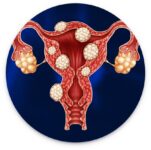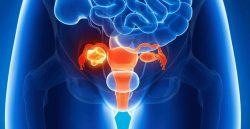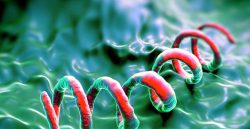Посты автора caesar
caesar
https://dorfmanm.ruhttps://www.youtube.com/watch?v=0-S8my4dU_4
Причины появления миомы матки
На ранних этапах возникновения миомы матки обычно не возникает никаких жалоб. Первые симптомы появляются лишь при быстром росте узла и увеличении размеров матки, подслизистой локализации узлов, нарушении питания в узле. Именно поэтому регулярное посещение врача и, в особенности, при возникновении беспокоящих симптомов, должно стать правилом жизни любой женщины.
Гормональные нарушения
Нарушения концентрации половых гормонов считаются самой главной причиной развития миомы матки. Миома матки возникает при снижении концентрации прогестерона на фоне повышенного уровня эстрогенов. Гормональными нарушениями объясняется еще и тот факт, что миома матки одно из наиболее распространенных заболеваний в репродуктивном возрасте. Также риск развития миомы матки увеличивается в постменопаузе у женщин, на фоне приема препаратов содержащих эстрогены. В последние годы всё больше специалистов склоняются к мнению, что даже такой симптомокомплекс, как альгодисменорея (нарушение менструального цикла, сопровождающееся болезненностью), также можно рассматривать в качестве одной из причин миомы матки.
Гинекологические операции
Аборты, кесарево сечение, установление спирали, гистероскопии и диагностические выскабливания могут быть одной из причин роста миоматозных узлов.
Хронические гинекологические заболевания
Хронические воспалительные заболевания придатков матки, эндометриоз, опухоли яичников приводят к гормональным нарушениям и в последствии к росту миоматозных узлов. Например, некоторые опухоли яичников способствуют повышению уровня эстрогенов в организме, что приводит к росту узлов миомы матки.
Стрессовые состояния
Совсем недавно ученые обнаружили, что существует прямая связь между стрессом и миомой матки.
Эндокринные заболевания
Миома матки чаще развивается на фоне заболеваний щитовидной железы, надпочечников и сахарного диабета.
Ожирение
Ожирение – еще один из факторов, повышающий вероятность возникновения миомы. Повышенное содержание углеводов в рационе приводит к увеличению уровня эстрогенов в организме и как результат – развитию миомы. Также опасным последствием неправильного питания является лишний вес. У тучных женщин риск развития миомы еще выше. Некоторые источники утверждают, что лишний вес в сочетании с отсутствием физической активности, а также частыми серьезными стрессами в большой степени способствуют развитию миомы матки.Подробнее о лечебном питании по ссылке.
Качество половой жизни
Частая смена половых партнеров приводит к нарушению функции половых органов женщин. Связано это с инфекционными заболеваниями, передающимися половым путем. Инфекционные заболевания являются причиной гормональных изменений, которые в последующим могут приводить к образованию миоматозных узлов.
Региональные особенности
Статистически отмечено, что у женщин, которые проживают на юге, например, на Кавказе, а также у представительниц негроидной расы, риск развития опухоли значительно выше.
Генетическая предрасположенность
Причины появления миомы матки также можно проследить по генетической линии: семейная предрасположенность, частое возникновение миомы у гомозиготных близнецов или, например, у представительниц негроидной расы. Однако в настоящее время теория об абсолютной генетической предопределенности миомы уже не рассматривается в качестве основной.
Causes of female infertility
A disease should be understood as a violation of organ function, accompanied by pain, swelling, fever, redness, expressed to one degree or another. Acute inflammation usually begins in the vulva and is the result of infection through sexual intercourse. After a certain period of time, called incubation (depending on the pathogen, it can be from 1 day to several weeks), discharge appears from the urethra and / or vagina. They can have a pus-like, slimy, frothy or cheesy appearance, can be abundant, scanty, observed only in the morning, or, when passing into a chronic form, be episodic. In this case, the patient may be bothered by itching, burning, sometimes pain when urinating or independently of it. Without treatment or with improper treatment, such acute phenomena gradually subside, but the infection is not eliminated, but becomes chronic. Ascending pathogens penetrate the internal genital organs, causing their inflammatory development. Signs of the inflammatory process of the internal genital organs are pain in the lower abdomen, groin, lower back, in men – the testicles, sometimes radiating to the inner thighs.
Types of female infertility
The diagnosis “female infertility” is heard by about every second married couple who are unsuccessfully trying to conceive a child.
Depending on what factors prevent conception and pregnancy, the following types of female infertility are distinguished:
- tubal and peritoneal infertility;
- endocrine infertility;
- uterine infertility;
- immunological infertility;
- psychological infertility;
- unclear infertility.
Tubal and peritoneal infertility
Tubal infertility occurs due to anatomical and functional disorders of the fallopian tubes, peritoneal – due to the adhesions in the small pelvis. In most cases, these two types of infertility are combined with each other and are referred to as tubal peritoneal infertility (TPI).
Endocrine infertility
Endocrine or hormonal infertility, as a rule, occurs in infertile women who suffer from various pathological changes in the menstrual cycle (shortening the time of menstrual bleeding to one or two days, lengthening the menstrual cycle for more than thirty-five days, absence of menstruation – amenorrhea). < / p>
Such infertility can also be suspected in patients with clinical signs of excess production of male sex hormones, hyperprolactinemia, insufficient production of estrogen, or metabolic disorders (obesity or dystrophy). It is this type of infertility that occurs in women with Itsenko-Cushing’s syndrome or disease, hypothyroidism, hyperthyroidism and other hormonal diseases.
Uterine infertility
The cause of uterine infertility is uterine malformations, infectious and inflammatory processes in the organ, benign tumors (polyps, fibroids, fibroids, fibroids), as well as tumor-like formations – cysts. Very often, pregnancy does not occur due to problems with the cervix, which occur due to genital infections, inflammation or erosion of the cervix.
Immunological infertility
This type of infertility is diagnosed by performing a postcoital test. It is carried out only when hormonal, tubo-peritoneal and uterine infertility are excluded. Immunological disorders occur in about 2% of cases of infertility and are associated with the appearance of substances in the cervical mucus that damage or even destroy male germ cells – sperm.
Psychological infertility
Various stressful situations lead to psychological infertility: intra-family conflicts, a tense atmosphere at work, a very strong desire to get pregnant, or, conversely, fear of motherhood. As a result, menstrual irregularities occur in a woman’s body, imitating hormonal infertility. In addition, stress leads to disruption of the autonomic system and, as a result, functional tubal obstruction appears due to discordant, uncoordinated movement of the smooth muscles of the fallopian tubes.
Infertility of an unclear nature
Infertility of an unclear nature is a diagnosis of exclusion. It is installed after standard and specialized diagnostic methods, as well as excluding all known types of infertility.
https://www.youtube.com/watch?v=NETRrUO63O0
https://www.youtube.com/watch?v=NETRrUO63O0
https://www.youtube.com/watch?v=_sI_Ps7JSEk
https://www.youtube.com/watch?v=_sI_Ps7JSEk
Infertility
What to do and what to do in case of infertility? – instruction from A to Z
Quick and correct determination of the cause of infertility (infertility) of a married couple is the main factor determining the success of infertility treatment.
Algorithm of your actions
Consultation
Consultation with a gynecologist-reproductologist (if there is a male factor of infertility, consultation with an andrologist).
Preliminary examination
Preliminary clinical and laboratory examination.
Re-consultation
Repeated consultation with a gynecologist-reproductologist to determine the tactics of treatment. Modern methods of infertility treatment include: Medication, Laparoscopy and assisted reproductive technologies (ART).
Preliminary preparation for laparoscopy
Prior preparation is required if laparoscopy is required.
In the presence of concomitant somatic diseases, consultations of related specialists and the necessary additional examination are carried out.
Myoma
The uterus is a muscular organ and consists of three layers, the thickest of which is the myometrium (muscle layer).
Myoma of the uterus is a benign hormone-dependent tumor, which is characterized by the development of nodes in the muscle layer. Uterine fibroids are often found in women aged 35-50 years, but recently there has been a tendency to rejuvenate the disease (in women 25 and younger).
Ovarian cysts
The uterus is a muscular organ and consists of three layers, the thickest of which is the myometrium (muscle layer).
Myoma of the uterus is a benign hormone-dependent tumor, which is characterized by the development of nodes in the muscle layer. Uterine fibroids are often found in women aged 35-50 years, but recently there has been a tendency to rejuvenate the disease (in women 25 and younger).
Endometriosis
Pain with endometriosis is usually chronic. They can get worse on the eve and during menstruation. The pain may become less intense during pregnancy and sometimes even go away on its own without any treatment.
Many women may not have any endometriosis at all for many years or even throughout their lives.
Many of the above symptoms are not specific and are found in many other diseases, so sometimes the diagnosis of endometriosis is quite difficult and requires a long and thorough diagnostic search.
Pelvic prolapse
Regardless of the etiology, pelvic prolapse is an anatomical problem requiring surgical treatment to restore support to the pelvic structures. It will not be possible to cure prolapse with pills and folk remedies, but it is quite possible to bring the problem to the prolapse of the uterus, delaying the treatment. When treating prolapse, it is recommended:
- Obstetric pessary insertion. Pessaries are a removable device inserted into the vagina to support the pelvic organs. They come in different shapes and sizes. Some types of pessary are suitable for treating pelvic organ prolapse and urinary incontinence. These devices are recommended for use in patients with severe symptoms and contraindications for surgery. It is important to understand that by refusing radical treatment, you will have to put an end to your intimate life.
- Pelvic floor muscle therapy. Exercises for the pelvic floor muscles help women with mild stages of pelvic organ prolapse (when it is still too early to call for the help of a surgeon) and with urinary incontinence. Exercise involves tensing and relaxing your pubococcygeal muscles several times a day to train them and increase pelvic floor support.
- Changing your eating habits. Eat more fiber-rich foods that prevents constipation and straining during bowel movements.
- Surgical treatments. During surgery, the surgeon uses the woman’s own tissues or a special mesh to restore the position of the organs and support the pelvic floor. The doctor tightens the weakened muscles and sutures them to the strong ones. The muscle replacement mesh is made of biocompatible material. This type of surgery is recommended for sexually active women with severe vaginal or uterine prolapse.
Pathology of the uterus
In the absence of pregnancy, endometrial rejection occurs. There are certain limits for the thickness of the endometrium for each day of the menstrual cycle. If the thickness of the endometrium is less than normal, we can talk about a thin endometrium (endometrial hypotrophy), with an increase in the size of the thickness of the endometrium, we can talk about pathological thickening of the endometrium (endometrial hyperplasia). Normally, the thickness of the endometrium in the first 2 days after the end of menstruation should be no more than 3 mm, and on periovulatory days, not less than 10 mm.
Both congenital malformations of the uterus and acquired diseases of the uterine cavity are the cause of infertility.
These developmental anomalies and diseases include the following diseases:
- One-horned and two-horned uterus.
- Hypoplasia (underdevelopment) of the uterus, rudimentary uterus.
- Complete and incomplete septum of the uterus.
- Pathology of the cavity uterus (endometrial hyperplasia, endometrial polyposis, endometrial polyposis).
- Endometriosis of the uterus.
- Intramural uterine myoma with centripetal growth.
- Submucous uterine myoma.
Inflammatory diseases
A disease should be understood as a violation of organ function, accompanied by pain, swelling, fever, redness, expressed to one degree or another. Acute inflammation usually begins in the vulva and is the result of infection through sexual intercourse. After a certain period of time, called incubation (depending on the pathogen, it can be from 1 day to several weeks), discharge appears from the urethra and / or vagina. They can have a pus-like, slimy, foamy or cheesy appearance, can be abundant, scanty, observed only in the morning or, when passing into a chronic form, be episodic. From him. Without treatment or with improper treatment, such acute phenomena gradually subside, but the infection is not eliminated, but becomes chronic. Ascending pathogens penetrate the internal genital organs, causing their inflammatory development. Signs of the inflammatory process of the internal genital organs are pain in the lower abdomen, groin, lower back, in men – the testicles, sometimes radiating to the inner thighs.
Infection of the internal genital organs can also occur in the hematogenous way if there are foci of acute or chronic infection in the body, such as tonsillitis, sinusitis, frontal sinusitis, otitis media, carious teeth, chronic pneumonia, cholecystitis, pustular skin lesions, etc. infections, the disease most often has an acute onset and purulent character. The lymphogenous pathway of penetration is possible in inflammatory-purulent diseases of the adjacent pelvic organs, for example, prostate disease may be caused by proctitis or thrombophlebitis of hemorrhoidal veins. Upper urinary tract and internal genital tract infections are more serious, but lower urinary tract infection or inflammation is more common.
Sexual infections
Genital herpes is a highly contagious viral disease that is transmitted through sexual contact and enters the body through microcracks in the skin. The causative agent of the disease is the herpes virus type II.
The main manifestations last three to four weeks, include tingling or mild soreness in the genital area, itching, small painful blisters and sores in the anus, buttocks or thighs, severe burning, especially in contact with urine, swollen inguinal lymph nodes … Even after the symptoms disappear, the virus remains in the body for life, periodically causing exacerbations.
For pregnant women, it is very important to cure herpes before childbirth, as the virus can be transmitted to the baby when passing through the birth canal. This can lead to blindness, brain damage, and sometimes death of the child.
Syphilis is a highly contagious infection caused by spirochetes and transmitted through any type of sexual intercourse. It is most common among people with multiple sexual partners, especially those who do not use barrier methods of contraception.
The first stage of the disease begins approximately 10 days after infection and manifests itself in the form of a painless hard chancre (ulcer) on the external genitals, anus, and less often fingers, hands, the infection can be brought into the oral cavity. As a result, the same ulcers appear in the mouth and throat. Another characteristic symptom is enlarged lymph nodes.
If untreated, the infection progresses and can progress into the following two stages. The third is the most severe. It is characterized by the appearance of skin rash all over the body (including palms and soles), which may be permanent or periodically disappear , ulcers in the oral cavity and pharynx, enlarged lymph nodes throughout the body, headaches, pain in bone tissue, fever, loss of appetite, and hair loss, meningitis (inflammation of the lining of the brain). At this stage, serious complications arise, such as paralysis, heart deviations, mental illness. The damage to the body can be severe enough to cause death.




